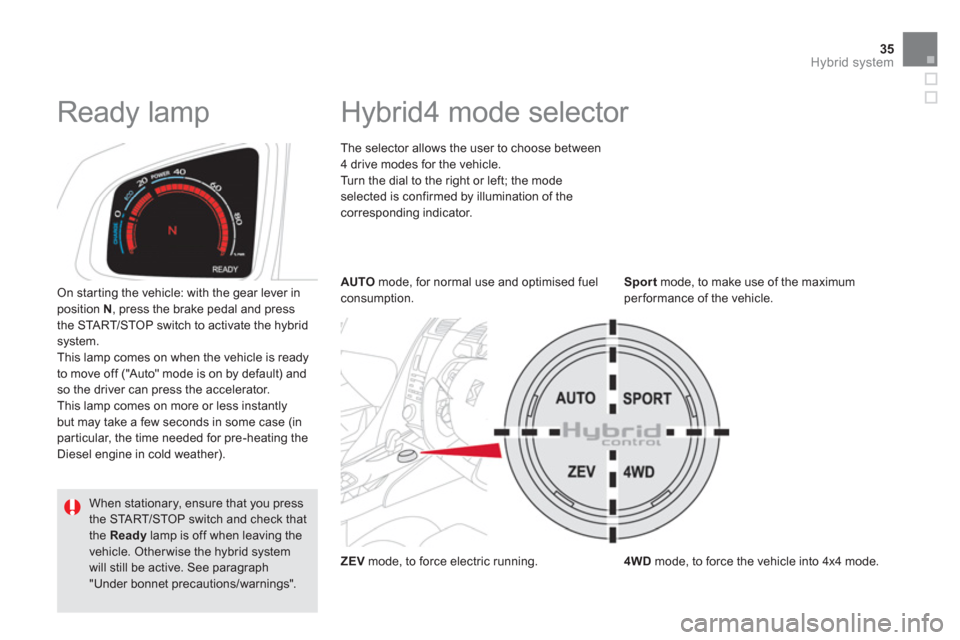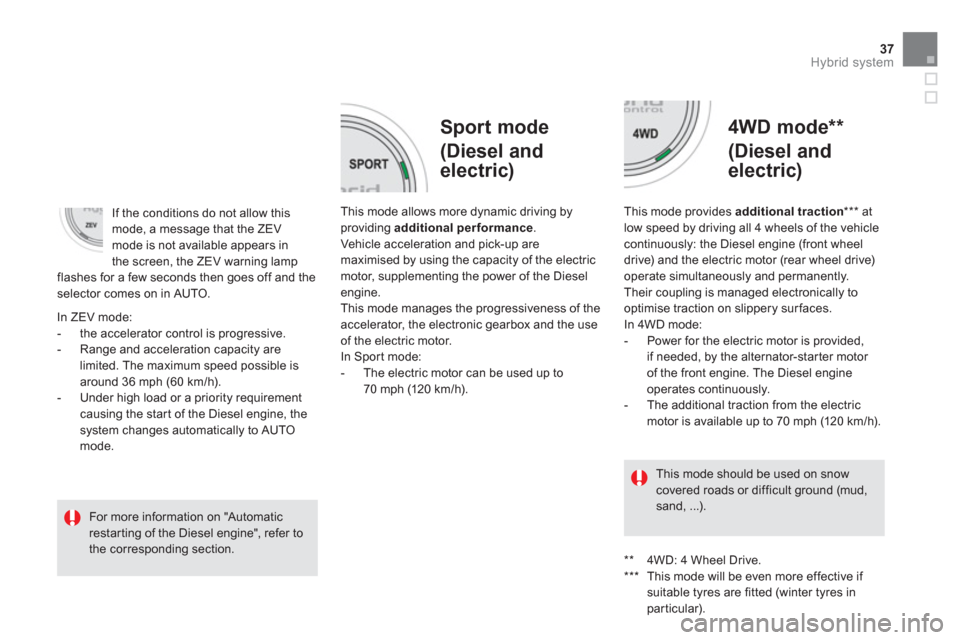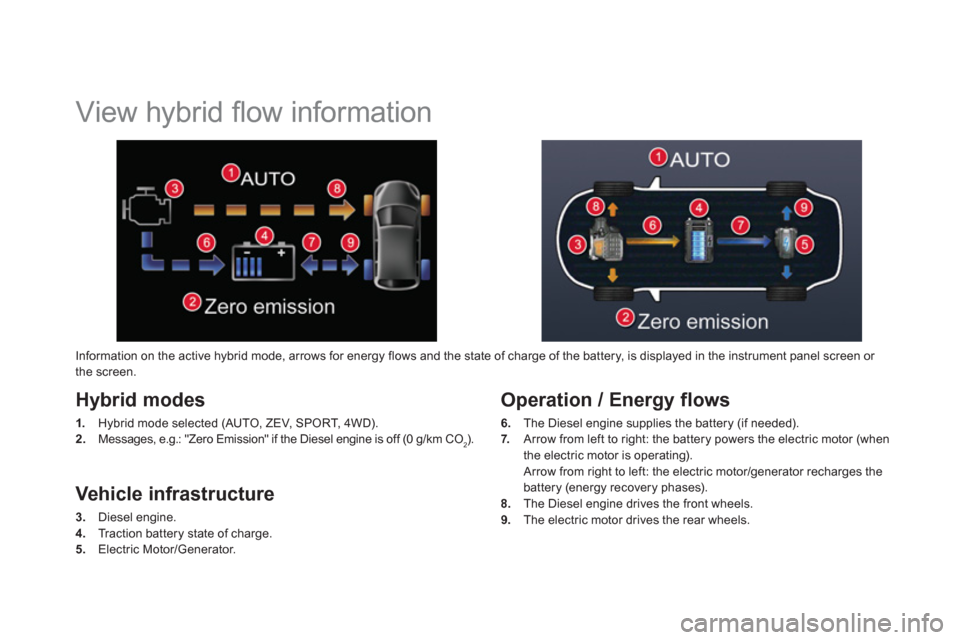4WD Citroen DS5 HYBRID4 RHD 2011.5 1.G Owner's Manual
[x] Cancel search | Manufacturer: CITROEN, Model Year: 2011.5, Model line: DS5 HYBRID4 RHD, Model: Citroen DS5 HYBRID4 RHD 2011.5 1.GPages: 358, PDF Size: 10.77 MB
Page 37 of 358

35
Hybrid system
Hybrid4 mode selector
The selector allows the user to choose between
4 drive modes for the vehicle.
Turn the dial to the right or left; the mode
selected is confirmed by illumination of thecorresponding indicator.
ZEVmode, to
force electric running.S
portmode, to make use of the maximum performance of the vehicle.
4WDmode, to force the vehicle into 4x4 mode.
AUTOmode, for normal use and optimised fuelconsumption. On star ting the vehicle: with the gear lever in position N, press the brake pedal and press
the STA R T/STOP switch to activate the hybrid system.
This lamp comes on when the vehicle is ready
to move off ("Auto" mode is on by default) andso the driver can press the accelerator.
This lamp comes on more or less instantlybut may take a few seconds in some case (in particular, the time needed for pre-heating the
Diesel engine in cold weather).
Ready lamp
When stationary, ensure that you press the STA R T/STOP switch and check that the Readylamp is off when leaving thevehicle. Otherwise the hybrid systemwill still be active. See paragraph "Under bonnet precautions/warnings".
Page 39 of 358

37
Hybrid system
Sport mode
(Diesel and
electric)
4WD mode **
(Diesel and
electric)
This mode allows more dynamic driving byproviding additional performance.Vehicle acceleration and pick-up are
maximised by using the capacity of the electric
motor, supplementing the power of the Diesel
engine.
This mode manages the progressiveness of theaccelerator, the electronic gearbox and the use of the electric motor.
In Sport mode:
- The electric motor can be used up to 70 mph (120 km/h).
This mode provides additional traction
***
at
low speed by driving all 4 wheels of the vehicle continuously: the Diesel engine (front wheel
drive) and the electric motor (rear wheel drive)operate simultaneously and permanently.
Their coupling is managed electronically tooptimise traction on slippery sur faces.
In 4WD mode:
- Power for the electric motor is provided,
i
f needed, by the alternator-star ter motor
of the front engine. The Diesel engine
operates continuously.
- The additional traction from the electricmotor is available up to 70 mph (120 km/h). In ZEV m
ode:
- the accelerator control is progressive.
- Range and acceleration capacity are
limited. The maximum speed possible is
around 36 mph (60 km/h).
- Under high load or a priority requirement causing the star t of the Diesel engine, the
system changes automatically to AUTO mode.I
f the conditions do not allow this mode, a message that the ZEV mode is not available appears in
the screen, the ZEV warning lamp
flashes for a few seconds then goes off and theselector comes on in AUTO.
This mode should be used on snowcovered roads or difficult ground (mud, sand, ...).
For more information on "Automatic
restarting of the Diesel engine", refer to the corresponding section.
**
4WD: 4 Wheel Drive.
***
This mode will be even more effective if suitable tyres are fitted (winter tyres inparticular).
Page 42 of 358

View hybrid fl ow information
Hybrid modes
1.
Hybrid mode selected (AUTO, ZEV, SPORT, 4WD).
2.
Messages, e.g.: "Zero Emission" if the Diesel engine is off (0 g/km CO2).
Operation / Energy flows
6.
The Diesel engine supplies the battery (if needed).
7.Arrow from left to right: the battery powers the electric motor (when
the electric motor is operating).
Arrow from right to left: the electric motor/generator recharges the
battery (energy recovery phases).8. The Diesel engine drives the front wheels. 9.The electric motor drives the rear wheels.
Vehicle infrastructure
3.
Diesel engine.4.
Tr a c t i o n b a t t e ry state of charge. 5.
Electric Motor/Generator. Information on the active h
ybrid mode, arrows for energy flows and the state of charge of the battery, is displayed in the instrument panel screen or
the screen.
Page 250 of 358

Identifi cation markings
A.Vehicle Identification Number (VIN) under the bonnet.This number is engraved on the bodyworknear the damper support.
The tyre pressures must be checked when the tyres are cold, at least oncea month.
If the tyre pressures are too low, thisincreases fuel consumption.
B.Vehicle identification Number (VIN) on
the windscreen lower crossmember.This number is indicated on a self-adhesive label which is visible through the windscreen.
C.Manufacturer's label. The VIN is indicated on a self-destroyinglabel affixed to the door aper ture, on the
passenger's side.
D.Tyre/paint label. This label is affixed to the centre pillar, on
the driver's side. It bears the followin
g information:
- the tyre inflation pressures with and without
load,
- the wheel rim and tyre sizes,
- the brands of tyre recommended by the manufacturer,
- the inflation pressure of the spare wheel,
- the paint colour code.
The use of snow chains is onlyauthorised on the front wheels.
The selector must be in 4WD mode.